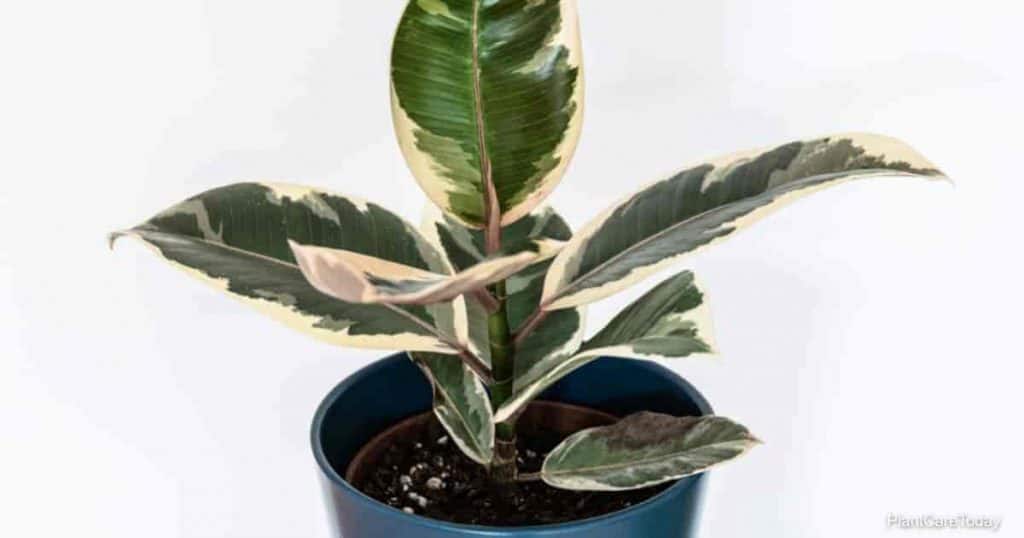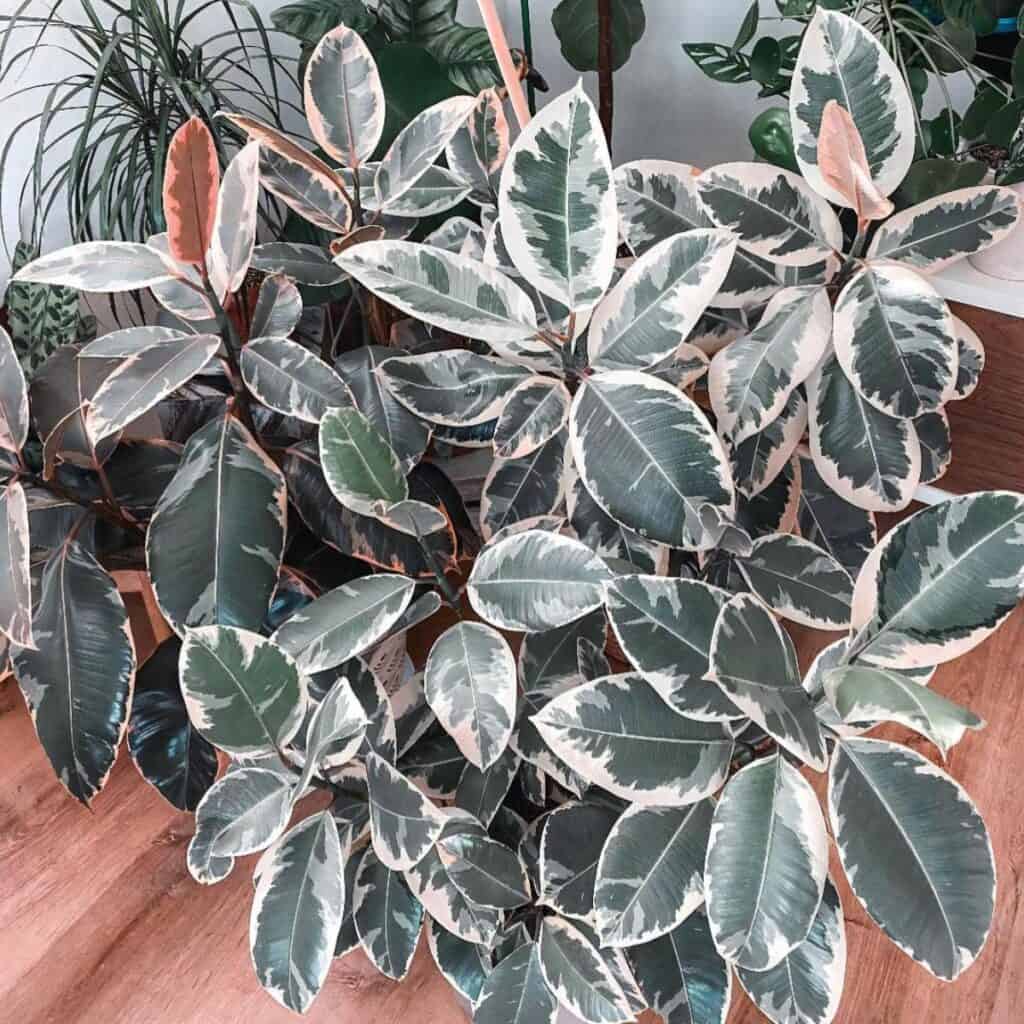[ad_1]
What’s a Ficus Elastica Tineke? The Tineke is a choose number of Ficus elastica and a “new” extremely variegated rubber plant available on the market. Folks love the camouflage foliage sample.” Under I put collectively an entire care information for Ficus Tineke.

Fast Ficus Tineke Care Ideas
Botanical Title: Ficus elastica ‘TinekeCommon Title(s): Rubber Plant Tineke, Variegated rubber Tree, Tineke rubber plantSynonyms: Ficus Tineke, Ficus elastica variegataFamily & Origin: Moraceae household, native to Southeast Asia, India and IndonesiaGrowability: Straightforward to growGrow Zone: USDA zones 10-11Size: Grows to 2-10′ ft tall indoors and 5′ inches wideFlowering: Hardly ever flowers indoorsLight: Brilliant, oblique sunlightHumidity: Prefers excessive humidityTemperature: 60-75° levels FahrenheitSoil: Effectively-draining soilWater: Water when the highest inch of soil dries outFertilizer: Diluted liquid fertilizer as soon as a month throughout rising seasonPests & Illnesses: Mealybugs, spider mites, scale bugs, root rotPropagation: Stem cuttings and air-layersPlant Makes use of: Air air purifier, ornamental flooring plant
Ficus Elastica Tineke Care- The Fundamentals
Dimension and Progress Charge
Ficus Teneke grows as a small indoor plant reaching 2′ – 10′ ft tall tree or bush. Rising outdoor in USDA Hardiness Zones 10b to 11, bushes can attain 50′ ft tall and extra.
Tineke rubber tree shows hanging variegation of cream to nearly white and inexperienced leaves. The mature shiny leaves of Tineke attain as much as 12″ inches lengthy and 5″ inches extensive. The sheath on the prime of the stem can also be a deep burgundy-red shade. Some recommend the distinctive shade of the leaf seems to be nearly like watercolor.
The burgundy rubber tree is a fast-growing Ficus. Variegated Ficus has much less chlorophyll and grows at a slower tempo.
Flowering and Perfume
Sorts of ficus elastica’ do flower. However solely flower when grown outdoor of their native dwelling of Malaysia, Java, or the Himalayas. Flowering indoors is a uncommon incidence. When Ficus elastica tineke does flower, they’re easy white blooms.
Its minimal perfume solely attracts fig wasps and no other forms of pollinators.

Ficus Tineke Gentle Necessities and Temperature
The perfect Ficus elastica Tineke does finest indoors with vivid, oblique gentle. In decrease gentle situations, new leaves produce much less creamy variegation. Crops are also much less prone to produce new wholesome development.
If the leaves are shedding their variegation, transfer your plant to a vivid gentle location.Indoors preserve a median room temperature above 55° levels Fahrenheit. Give Tineke reasonable humidity ranges with smooth morning daylight. Take into account including a humidifier to extend humidity.Bear in mind, an excessive amount of gentle can scorch the foliage of Tineke Rubber vegetation. In distinction, too little gentle might imply duller colours and fewer variation from dry warmth.Ficus Tineke could be finicky to temperature. It doesn’t tolerate inconsistent temperatures. Sudden temperature drops, chilly drafts, and moist or dry situations will have an effect on your plant.On the flip facet, in case your leaves are crispy and have brown spots, your plant could also be too dry or get an excessive amount of solar publicity.

How you can water and feed Ficus Tinekes: Watering Wants
The favored rubber Tineke is a comparatively low-maintenance houseplant. Forestall overwatering rubber vegetation.
If the roots sit in extra water, they will endure from root rot, and fungus gnats can turn out to be a difficulty. Enable the highest one inch of soil to dry out earlier than watering as soon as each one to 2 weeks once more.
The indoor tinekes nonetheless get pleasure from deep watering in accordance with the pure rising season. Water your plant extra in the course of the summer season months and reduce in the course of the winter weeks for good steadiness.
Utilizing Fertilizer
Feed your new Ficus species month-to-month throughout heat temperatures. Use a half-strength balanced liquid fertilizer.
Potting, Soil, And Transplanting
The tineke variegated rubber tree plant thrives in gentle, well-draining, moist soil. It will possibly tolerate heavy clay, sandy, loamy, or dry soil. Bear in mind to make use of a pot with drainage holes.
When transplanting, decide a pot that’s solely a bit of bigger in diameter than the unique one. Deciding on a pot too large may cause widespread issues with retaining extreme moisture and soggy roots. Select a well-draining potting combine. Elastica vegetation wish to be barely potbound.
It does properly in both acidic or alkaline soil. Whatever the Ficus selection, these vegetation will develop indoors. Don’t overpot. Your Tineke Rubber plant must be advantageous within the pot it was bought for a 12 months.
In case your plant will get top-heavy, use a cachepot to maintain the top-heavy rubber tree from falling over.
Repotting is essential to permit the roots to develop regularly. Plus, a recent wealthy soil combination will rejuvenate the plant. When repotting, repot in the course of the early spring. Ficus reveals shock by dropping leaves.

Tineke Rubber Tree Pruning and Upkeep
As houseplants, the tineke rubber tree is not going to want a lot grooming. Mature vegetation want pruning to take care of their form or take away undesirable branches.
Pruning the principle branches helps obtain a bushier, fuller, and extra spectacular form. Utilizing a clear, sharp blade, minimize off a six-inch portion of a wholesome department simply above a leaf node. For a extra slender tree-like look, prune not often.
Massive rubber plant leaves gather mud. Every now and then, clear the thick, waxy leaves with a humid fabric.
Your potted tropical rubber Tineke tree might develop aerial roots because it will get bigger. Open air these fast-spreading roots assist stabilize the tree however are usually not obligatory. Eradicating these aerial roots is not going to injury your plant. When eradicating them, make a clear, sharp minimize.
As for the plant development, foliage decrease on the plant will drop off to focus power on newer development. Though some leaf development is misplaced naturally, letting your plant get too dry can encourage leaf drop.

Propagating Ficus Tineke
Ficus elastica Tineke is straightforward to propagate. You can begin a brand new rubber tree by air layering. The layering propagation methodology will not be troublesome., however does take some follow to get it proper.
The method is straightforward however can get messy because of the milky sap it oozes when minimize. However propagating Tineke from stem cuttings makes rooting new variegated rubber vegetation straightforward.
Select a department to propagate and take a reducing about 12″ inches lengthy.Take away the decrease oval leaves.Apply a rooting hormone to the bottom of the tip-cutting.Place into a brand new pot stuffed with well-draining soil.Water and place a plastic bag over the pot to create a synthetic greenhouse. A soda bottle works properly, too.Place your new reducing in a vivid, heat location in entrance of a vivid south, east or west-facing window with no direct daylight.New roots ought to kind in 30-60 days.As soon as your new Ficus is properly established, repot into a bigger 6″ pot.
NOTE: The sap of Tineke Ficus may cause pores and skin irritation

Ficus Tineke Plant Pests or Illnesses
The most important pests problem for variegated Tineke are leaf and root mealybugs, aphids, plant scales, bugs, weedy thugs, and spider mites.
Like different rubber vegetation, Ficus Tineke is typically susceptible to fungal ailments similar to Anthracnose.
All variegated Ficus varieties appear to endure from some type of brown spots on the leaves. What causes brown spots?
An excessive amount of direct gentle can burn leaves as a result of extended publicity.Low humidity can dry the leaves.Over-fertilizing may end up in burns from salt buildup.
Ficus Rubber Bushes don’t like adjustments. They like:
Constant Temperatures – When uncovered to drops in temperature, they reply by dropping leaves.
Moist Not Moist Soil – If the soil stays too dry after which stays moist. Roots turn out to be mushy and begin to die. Leaves flip yellow and fall off.
Brilliant oblique gentle – Ficus produces leaves based mostly on the tropical gentle they obtain. When the leaves don’t “match” the lighting situations. The untimely leaf drop shall be on the leaves.
To maintain your Tineke ficus plant trying its finest, don’t neglect to mud the leaves with a microfiber fabric. For finest outcomes, give your Tineke correct care. Don’t neglect to show it on periodically.
Ficus Information
The place Does Ficus Elastica Originate?
Variegated ficus elastica originates in Southeast Asia, India, and Indonesia.
The place Does Ficus Elastica Originate?
The straightforward-to-find cultivar ficus tineke belongs to the Moraceae household. The plant’s genus identify means “edible fig.”
[ad_2]
Supply hyperlink
